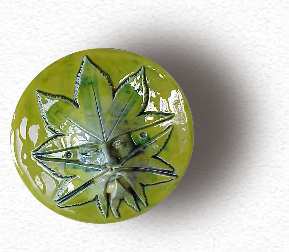Foreword
If
you are already a devotee of the Green Man, I hope that this article
assists your quest in North Yorkshire and the East Riding. If you
are a newcomer to the Green Man, of whom more later, welcome to his
following.
I had intended to write a Green Man guide just to Ryedale, but so
far, despite the fact that I have visited most of the some 120 churches,
there are insufficient sightings to warrant it. I have thus extended
the brief to include areas around Ryedale.
What
constitutes a Green Man sighting? My view is possibly more purist
than some. To my mind, a sighting is a Green Man if the representation
is:
* apparently intended to be a Green Man per se, and
* is of a human figure, usually just the head, with
* foliage being a constituent part of the figure; the figure being
intertwined with, emerging from, or dissolving into vegetation, or
vegetation being disgorged from the figure.
Regrettably, because of vandalism and theft (for instance, the lectern
with its four Green Men has been stolen from Burton Agnes church),
many churches are locked. I see no point in indicating whether I found
a church open or locked, or, for the latter, where I found the key,
as it is likely that the situation will be different by the time you
get there.
May I suggest that on your quest you take a good torch and short focus
binoculars.
I have had so much pleasure in visiting so many churches, that I feel
that it would be a shame if a listing of Green Man sightings constrained
the reader to visiting only those on that list. Most have an individual
charm, or subject of interest. To broaden the field, I have thus included
in the Ryedale list those which I remember as having been particularly
fascinating - I apologise if my omissions offend any parishioners.
Encouraging this broader view, my classification code is:
C - A Confirmed Green Man sighting
M - Maybe a sighting - see what you think
P - Great Potential for a Green Man, but I didn't find him
V - Very worth a Visit, despite there being no Green Men to my knowledge.
It has already been said that, if you visit a church and don't find
a Green Man, it doesn't mean that he isn't there; it simply means
that you haven't found him!
My list is not exhaustive. I am not infallible in my searching. There
are many churches yet to visit. I have had no sightings on such potentially
fruitful places as stained glass, wrought-iron work, tombstones, effigies,
monuments, or antiquities. I thus welcome any suggested additions
to my list, corrections, or differences of opinion.
For reasons of fairness and copyright, I have not included the sightings
by others that I have not yet seen for myself (at least, not without
a 'said to be' comment, when I have sighted a Green Man on the exterior,
but haven't been able to get inside to see any said to be there).
Lastly, may I express my gratitude to the many churchwardens and others,
who have patiently listened to my Green Man ramblings, and kindly
accompanied me or allowed me to borrow church keys.
Bruce Skinner
Telephone: 01944 768276
E-mail: brucifers@bskinner3.freeserve.co.uk
ps. This article is offered for sale as a leaflet at Tourist Information
offices, etc.
If you download it from the Web, and it gives you enjoyment, perhaps
you'd like to make a donation to York Against Cancer, 31-33 North
Moor Road, Huntington, York, YO32 9QN, to whom and their like I am
eternally grateful.
An Introduction to the Green Man
The first thing to say is that the Green Man is rarely 'green'. Perhaps
it's easier to think of him as greenery, or foliage man, or, as the
Germans call him, 'man of the trees'.
In 'The English Parish Church', Russell Chamberlin simply refers to
him as 'the mysterious Green Man', which neatly sums up the whole
myth in one word.
To most residents of Ryedale, 'The Green Man' will conjure-up thoughts
of the hotel in Malton market place. However, the Green Man represented
on the hotel's inn sign, a Robin Hood character, is just one facet
of Green Man mythology.
Possibly because of the county's size, there are more Green Men sightings
listed in Clive Hicks' 'Field Guide' in Yorkshire than in any other
county.
Green Man artefacts and variants of the myth are found through Europe,
the Near East, the Indian sub-continent, Asia, the USA, and no doubt
beyond.
In the West, the Green Man is found mainly in wood carvings and decorative
stonework on churches and other worthy buildings. He is typically
represented by the foliate face of a man with greenery emerging from
the mouth, nostrils, or ears, or his eyebrows, hair, beard and facial
lines are foliage, or a decorative foliate motif or frieze will meld
from or into a man's face. The most common types of foliage are oak,
hawthorn, acanthus and vines.
But why the interest in the Green Man, and why now? Opening the subject
with questions is appropriate, because it will be seen that there
are many questions but few answers.
Where did he come from?
Our Green Man is first found as a motif in Roman and contemporary
Byzantine and Hellenistic architecture in the 1st Century AD. He is
possibly a sober form of the god Bacchus, in turn derived from the
vegetation origins of the Greek god Dionysus; but this is just the
easiest-to-précis theory of the many explored in the books featured
in the bibliography.
My personal favourite extension of this, from my experience in Peru,
is the Druid connection. Druid means 'Knowing the Oak Tree', and Druids
worshipped in sacred groves of oak trees. This theory has it that,
as Christianity supplanted Druidism in Gaul, the Green Man was introduced
in Christian churches as a sop to the older religion.
A few of the more notable, medieval and later examples in Britain
are to be seen on Oxbridge colleges, the houses of Parliament, most
cathedrals, Rosslyn Chapel near Edinburgh, prolifically on churches
in Northamptonshire and Devon, and more locally in York and Beverley
Minsters, Selby Abbey, and famously on Fountains Abbey. The motif
first appeared in English churches in Norman times, and had a later
great resurgence of popularity in Victorian architecture.
The Green Man was certainly originally a pagan symbol, and reflects
man's origins and eventual resting place in mother earth, fertility,
creation and oneness with and dependence upon nature.
In the same vein are Jack in the Green in May Day revels, Robin Goodfellow
(from whom probably came the legend of Robin Hood), Morris Dancing,
the horn of plenty, the Tree of Life, Puck, Pan, holly at Christmas
and our use of mistletoe as a love charm.
I suppose that the mundane answers to "Why now?", are that
many of us now have more leisure time to seek-out and visit places
of interest, and that the Green Man has become a popular 'collectible'.
But mainly that the Green Man is being adopted as the new millennium's
equivalent of the CND badge of the sixties, an icon of our at-last-awakening
realisation of the fundamental importance of environmental and ecological
issues.
Other, typical questions are:
* It's 'Mother Nature' and 'Mother Earth'; so why are there so few
Green Women?
* The Green Man has pagan origins; so why was it adopted for Christian
churches?
* The Green Man rejoices in our relationship with nature, its bounty
and its annual regrowth; so why are there very few happy ones, and
most of them troubled or almost evil in countenance?
* Why is he often poking out his tongue, and why does he sometimes
have feline ears?
* Why is it a popular pub name? And why are there many more of these
in certain areas of the country than in others?
Green Man aficionados may just be 'spotters' of a mysterious architectural
artefact, probably intrigued by his folklore perpetuation from classical
mythology, or maybe more deeply interested in considering his philosophical
and psychological rationale. The books listed in the bibliography
below offer you this choice.
Personally, I'm simply an environmentally conscious hunter-gatherer,
who enjoys the thrill of the chase and the congenial surroundings.
But the knowledge that there is more to the Green Man than meets the
eye, provides an addictive, mystical frisson to the pastime.
Green Man Trails
Trail 1 - In Ryedale
* M - Allerston, St. John: Maybe a badly eroded Green Man on the N
side of the tower.
* P - Amotherby, St. Helen: The carved head to the left of the altar
is more like Munch's 'The Scream' than a Green Man.
* V - Appleton-le-Moors, Christ Church: A delightful Victorian church.
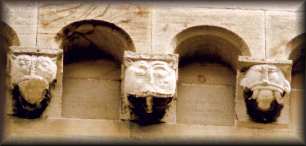 |
·
C - Barton-le-Street, St. Michael and All Angels - The jewel
in Ryedale's stone carving crown: In the south porch - Green
Men in both columns of the entrance arch*, on the right-hand
door post, and in the door arch. More on both capitals of the
chancel arch. Possibly a sheila-na-gig above the right hand
bench in the porch. (* and a Green Sheep and a Lion). Some 20
Green Men in total.
|
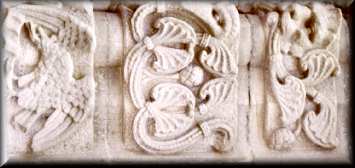 |
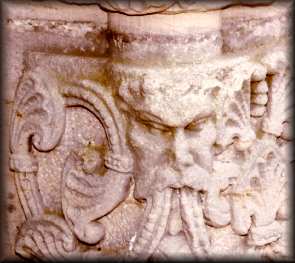 |
These
three pictures are to be found in St Michael and All Angels |
*
V - Beadlam, St. Hilda: I was captivated by the almost pre-Raphaelite
figure of a young woman on a memorial on the south wall of the nave.
* P - Birdsall, St. Mary: There are some ninety visible carved heads
on the pinnacles, the majority human. It seems inconceivable that
the Victorian stonemason didn't carve a single Green Man!
* V - Burythorpe, All Saints: A unique location.
* V - Buttercrambe, St. John the Evangelist: The chancel is at an
angle to the nave; said to represent the inclination of Christ's head
on the cross.
* V - Butterwick, St. Nicholas: Charming, when you find out how to
get to it!
* V - Crambe, St. Michael: The two, lovely carved characters on the
capitals of the tower arch could so easily have been Green Men!
* V - Ellerburn, St. Hilda: Delightful, both for its antiquity and
its position.
* V - Foston, All Saints: Famous for its Sidney Smith connection.
* C - Helmsley, All Saints: A modern, stylised Green Man on the corbel
table on the south side of the chancel.
* C - Helmsley, Duncombe Park: Splendid Green Men over the capitals
of the 8 Corinthian columns in the Stone Hall of this stately home.
A horned, bearded face (Dionysus, Pan, or ...?) shrouded in foliage,
above the main door
* C - Hawnby, All Saints: A Green Man behind the south door, in the
capital of the door post.
* V - Howsham, St. John: Delightfully different, Gothic Victorian
church. There could have been Green Men in the porch capitals!
* M - Kirby Grindalythe, St. Andrew: The Green Man high up on the
south side of the tower, has feline ears - see Langton. The gilded
Italian mosaic of The Resurrection, covering the west wall of the
nave is fantastic.
* M - Kirkbymoorside, All Saints: The roof boss nearest to the font
could be a Green Man, but he's very difficult to see.
* V - Kirkdale, St. Gregory Minster: Simply a 'must' to visit.
* C - Langton, St. Andrew: Others call the perhaps feline head, on
the left-hand capital of the chancel arch, a Green Man, however it
may be a Green Cat (see Mike Harding's 'Little Book .'). In this regard,
also see Old Malton and Kirby Grindalythe.
* V- Lastingham, St. Mary: Famous for its crypt and superb stone groined
vaulting.
* C - Malton, St. Leonard: Two Green Men on the tower arch corbels.
* V - North Grimston, St. Nicholas: A sheila-na-gig on the corbel
table on the NE exterior wall of the chancel, many of the other 'gargoyles'
on the N wall corbel table are said to be Viking gods. Wonderful decorated
Saxon font, featuring 'The Last Supper' and Christ's descent from
the cross.
* C - Norton, St. Peter: At least five Green Men on the pulpit.
* M - Old Byland, All Saints: A 'face on foliage background' roof
boss over the chancel.
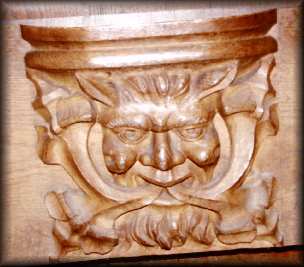 |
·
C - Old Malton, St. Mary Priory: One Green Man (with feline
ears - see Langton) in the Victorian misericord seats, and another*
on the baldacchino, immediately above the altar cross (needs
binoculars).
|
*
V - Pickering, St. Peter and St. Paul: Most famous for its frescoes.
* P - Salton, St. John of Beverley: Many eroded carved heads.
* C - Settrington, All Saints: Many Green Men on the tower.
* C - Sherburn, St. Hilda: Many Green Men on the newer font, on both
sides of the rood screen, and roof bosses in the North and South aisles.
* V - Sheriff Hutton, St. Helen and the Holy Cross: Famous for its
royal tomb.
* V - Stonegrave Minster: Another 'must'.
* M - Thornton le Dale, All Saints: Probably an eroded Green Man on
the N side of the tower.
* V - Weaverthorpe, St. Andrew: A really imposing Norman church, with
a wonderful barrel- vaulted roof, stunning stained glass, and a fabulous
tryptich reredos.
* V - West Lutton, St. Mary: This and St. Andrew, East Heslerton are
fine examples of Tatton Sykes' churches by Street. Fabulous Jesse
tree in west window, and painted ceilings.
* V - Westow, St. Mary: Different because of its remoteness.
* M - Wharram Percy, St. Martin: I think there are 3 or 4 eroded,
'disgorging' Green Men on the remains of the tower of this ruined
church.
* C - Wintringham, St. Peter: Two splendid Green Men on misericord
seats. More on the tower, on the choir stalls (fronts and a bench
end), on the choir screen, on the pulpit tester, on the south aisle
chancel screen, and I think that the many faces on the nave roof wall-plates
are connected by a creeper which passes through each's mouth.
Trail 2 - To the East of York
* C - Bishop Wilton, St. Edith: One Green Man on the right-hand side
of the south door arch. Maybe another on the right-hand side.
* C - Bugthorpe, St. Andrews: Two Green Men on the capitals of the
first chancel arch
* C - Great Givendale, St. Ethelburga: Three Green Men on the left-hand
capital of the chancel arch.
* C - Howden Minster: Green Men on choir stall poppy heads.
* C - Nunburnholme, St. James: Two Green Men on the right-hand capital
of the tower arch. Maybe another on the Norman tower arch
* C - Pocklington, All Saints: Three Green Men on the low capitals
under the tower, against the west wall
Trail 3 - Driffield/Beverley area
* C - Beverley Minster: Many Green Men in nave capitals, a corbel,
a misericord, in the choir carvings and the choir gates either side
of the altar, in the reredos, in the sedilia, in spandrels by the
minstrel carvings, in roof bosses in St. Katharine's chapel.
* C - Beverley, St. Mary: Many gilded Green Men in roof bosses, misericords
and a poppy head, on capitals in the porch, miniature carvings in
the rood screen.
* C - Bishop Burton, All Saints: A Green Man under the piscina in
the sanctuary.
* C - Bridlington Priory: A Green Man roof boss in the nave (3rd boss
from west window).
* C - Burton Agnes, St. Martin: Three Green Men on misericord seats.
* C - Driffield, All Saints: One splendid Green Man as the central
roof boss of the south porch.
* V - Fridaythorpe, St. Mary: Lovely, very old, Norman church. See
the keystone of the chancel arch, illuminated by the rood window,
and the face on the left capital of the door.
* P - Garton on the Wolds, St. Michael and All Angels: Many carved
heads on the exterior. Interior walls are fabulously covered in murals.
I can't find the Green Man said to be there.
* C - Langtoft, St. Peter: Four Green Men on roof bosses in north
and south aisles.
* C - Lund (near Middleton on the Wold), All Saints: A Green Man on
the exterior of the vestry to the north of the chancel.
* C - Rudstone, All Saints: A Green Man under the piscina in the sanctuary.
* M - Sledmere House: The faces at the base of the 16C, Venetian fire
dogs have acanthus beards.
* M - Sledmere, St. Mary: Maybe a stylised Green Man
on the north face of the tower, and perhaps the gutter header on the
north wall of the nave is a Green Man too. Inside the church, amongst
the many superb carvings there must be Green Men; however the nearest
I can find is a beast spewing the foliate frieze above the altar in
the north aisle.
* C - Wetwang, St. Nicholas: Two small Green Men on the external mould
of the window on the north wall of the chancel.
Trail 4 - To the West of Ryedale
* C - Alne, : Green Men on porch capitals and a feline Green Man on
the font
* C - Coxwold, St. Michael: Brightly painted Green Man on roof boss
above the door.
* C - Felixkirk, St. Felix: Green Men on capitals of 3 of the 4 restored
Norman pillars in the chancel.
* C - Ripon, Fountains Abbey: Famous (Kathleen Basford's) Green Man
above NE window of Chapel of Nine Altars.
* C - Ripon, Yorkshire Bank: Four Green Men on the upper frieze above
the shop front.
* C - Stillington, St. Nicholas: Miniature Green Men on the choir
stalls and a Green Man on the tower screen - all by the Mouse Man.
* C - Thirsk, St. Mary: Foliate faces on both sides of a poppy head
in the chancel. Many faces on foliage background roof bosses, and
many carved faces on roof trusses.
Trail 5 - To the South of Ryedale (incl. York)
* C - Bayton, St. Wifrid: Green Men on capitals of south
door (and 'said to be' on chancel arch).
* C - Escrick, St. Helen: Robed Green Man in exterior corner between
east wall of porch and south wall of nave.
* C - Leeds, St. John: Some of the carved heads on the superb, double-bayed
rood screen are foliate.
* C - Selby Abbey: Large gold roof boss in choir, miniatures in carved
friezes on choir stalls, stone roof boss in War Memorial Chapel, and
on font cover.
* C - Stillingfleet, St. Helen: Green Men on south door capitals and
on capital of column between nave and Moresby Chapel
* C - Ricall, St. Mary: Green Men on capitals and arch of south door.
* C - York, #34 Stonegate: Gilt and green Green Man on cross beam
at gable-end.
* C - York, All Saints, North Street: A really fabulous little church.
Many coloured Green Man roof bosses in the chancel, and unpainted
ones at the E end of N & S aisles
* C - York, All Saints, Pavement: Green Man on the lectern
* C - York, Banks' music shop (next to main Post Office): Green Men
on the decorative friezes at the top of the building
* C - York, Guildhall, Coney St.: An original Green Man roof boss
in the committee room. Very many painted Green Man roof bosses in
the restored Guildhall itself.
* C - York Minster: Many Green Men on capitals and roof bosses. Many
on roundels of Chapter House vestibule.
* C - York, St. Denys, St. Denys Rd.: Green Man on S door capitals
and in archivolts, but very eroded.
* C - York, St. Helen, St. Helen's Square: Green Man corbel in N aisle
and S corbel of wooden chancel arch.
* C - York, St. Margaret, Navigation Rd.: Green Men in archivolts
on S doorway, but quite eroded.
* C - York, St. Martin-le-Grand, Coney St.: Green Man roof bosses.
* C - York, St. Mary, Castlegate: A Green Man and Green Woman under
niches on the W side of the tower.
Trail 6 - To the North of Ryedale
* * C - Lythe, St Oswald: A Green Man on a capital fragment displayed
under the tower gallery.
* C - Whitby, St. Mary: A Green man on a capital.
Bibliography
There are many Green Man associated web sites; two very readable ones
being:
* www.mikeharding.co.uk
* www.endicott-studio.com/galgreen.html
For the more traditional, there is good reading on the subject in:
1. 'The Green Man' by Kathleen Basford
2. 'The Green Man - Companion and Gazetteer' by Ronald Millar
3. 'Green Man - the Archetype of our Oneness with the Earth' by William
Anderson
4. 'A Little Book Of The Green Man' by Mike Harding
5. 'The Green Man - A Field Guide' by Clive Hicks
6. ''The Green Man' the Pitkin Guide' by Jeremy Harte
7. 'The Green Man in Britain' by Fran & Geoff Doel
8. 'The Quest for the Green Man' by John Matthews
Most of these books are available at 'The Green Man Gallery', Pickering.
Copyright (c) 2003
B.Skinner
Rev. 9 26/03/2003
|


